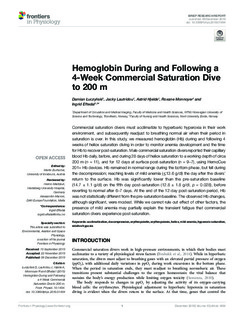| dc.contributor.author | Luczynski, Damian | |
| dc.contributor.author | Lautridou, Jacky | |
| dc.contributor.author | Hjelde, Astrid | |
| dc.contributor.author | Monnoyer, Roxane | |
| dc.contributor.author | Eftedal, Ingrid | |
| dc.date.accessioned | 2019-12-10T08:10:19Z | |
| dc.date.available | 2019-12-10T08:10:19Z | |
| dc.date.created | 2019-09-23T12:44:14Z | |
| dc.date.issued | 2019 | |
| dc.identifier.citation | Frontiers in Physiology. 2019, 10:1494 | nb_NO |
| dc.identifier.issn | 1664-042X | |
| dc.identifier.uri | http://hdl.handle.net/11250/2632379 | |
| dc.description.abstract | Commercial saturation divers must acclimatize to hyperbaric hyperoxia in their work environment, and subsequently readjust to breathing normal air when their period in saturation is over. In this study, we measured hemoglobin (Hb) during and following 4 weeks of heliox saturation diving in order to monitor anemia development and the time for Hb to recover post-saturation. Male commercial saturation divers reported their capillary blood Hb daily, before, and during 28 days of heliox saturation to a working depth of circa 200 m (n = 11), and for 12 days at surface post-saturation (n = 9–7), using HemoCue 201+ Hb devices. Hb remained in normal range during the bottom phase, but fell during the decompression; reaching levels of mild anemia (≤13.6 g/dl) the day after the divers’ return to the surface. Hb was significantly lower than the pre-saturation baseline (14.7 ± 1.1 g/dl) on the fifth day post-saturation (12.8 ± 1.8 g/dl, p = 0.028), before reverting to normal after 6–7 days. At the end of the 12-day post-saturation period, Hb was not statistically different from the pre-saturation baseline. The observed Hb changes, although significant, were modest. While we cannot rule out effect of other factors, the presence of mild anemia may partially explain the transient fatigue that commercial saturation divers experience post-saturation. | nb_NO |
| dc.language.iso | eng | nb_NO |
| dc.publisher | Frontiers Media | nb_NO |
| dc.rights | Navngivelse 4.0 Internasjonal | * |
| dc.rights.uri | http://creativecommons.org/licenses/by/4.0/deed.no | * |
| dc.title | Hemoglobin during and following a four-week commercial saturation dive to 200 meters | nb_NO |
| dc.type | Journal article | nb_NO |
| dc.type | Peer reviewed | nb_NO |
| dc.description.version | publishedVersion | nb_NO |
| dc.source.volume | 10 | nb_NO |
| dc.source.journal | Frontiers in Physiology | nb_NO |
| dc.source.issue | 1494 | nb_NO |
| dc.identifier.doi | 10.3389/fphys.2019.01494 | |
| dc.identifier.cristin | 1727791 | |
| dc.relation.project | Norges forskningsråd: 280425 | nb_NO |
| dc.description.localcode | Copyright © 2019 Łuczyński, Lautridou, Hjelde, Monnoyer and Eftedal. This is an open-access article distributed under the terms of the Creative Commons Attribution License (CC BY). The use, distribution or reproduction in other forums is permitted, provided the original author(s) and the copyright owner(s) are credited and that the original publication in this journal is cited, in accordance with accepted academic practice. No use, distribution or reproduction is permitted which does not comply with these terms. | nb_NO |
| cristin.unitcode | 194,65,25,0 | |
| cristin.unitname | Institutt for sirkulasjon og bildediagnostikk | |
| cristin.ispublished | false | |
| cristin.fulltext | original | |
| cristin.qualitycode | 1 | |

